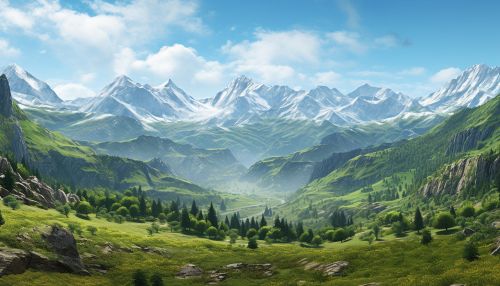Sierra Nevada (U.S.)
Geography
The Sierra Nevada is a significant mountain range located in the western part of the United States, primarily within the state of California. The range extends over 400 miles (640 km) from the Mojave Desert in the south to the Cascade Range in the north. The Sierra Nevada is bounded by the Great Basin and the Mojave Desert to the east, and the Central Valley of California to the west.


Geology
The Sierra Nevada is a batholith, a large mass of intrusive igneous rock that forms from cooled magma deep in the Earth's crust. The range is primarily composed of granite, a coarse-grained rock formed from slowly cooled magma. The Sierra Nevada batholith is one of the largest and most well-studied in the world, providing valuable insights into the processes of magma formation, intrusion, and cooling.
Climate
The climate of the Sierra Nevada is influenced by its altitude, latitude, and proximity to the Pacific Ocean. The range experiences a Mediterranean climate, with warm, dry summers and cool, wet winters. The western slope of the Sierra Nevada receives significant rainfall, while the eastern slope lies in the rain shadow of the range and is considerably drier.
Flora and Fauna
The Sierra Nevada is home to a diverse array of plant and animal species. The vegetation of the range varies with elevation, from chaparral and oak woodland at lower elevations to subalpine forests and alpine tundra at higher elevations. The range is also home to numerous species of mammals, birds, reptiles, and amphibians.
Human History
The Sierra Nevada has been inhabited by humans for thousands of years. The indigenous peoples of the Sierra Nevada, including the Miwok, Paiute, and Washoe tribes, utilized the resources of the range for sustenance and cultural practices. The arrival of European settlers in the 19th century, particularly during the California Gold Rush, had a profound impact on the indigenous cultures and the environment of the Sierra Nevada.
Recreation
The Sierra Nevada offers a wide range of recreational opportunities, including hiking, camping, fishing, skiing, and mountaineering. The range is home to several national parks and monuments, including Yosemite National Park, Sequoia National Park, and Kings Canyon National Park, which attract millions of visitors each year.
Conservation
Conservation efforts in the Sierra Nevada focus on preserving the range's unique ecosystems, protecting endangered species, and managing the impact of human activities. These efforts are led by various federal and state agencies, as well as non-profit organizations.
